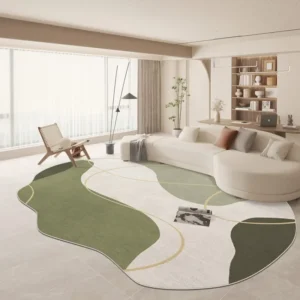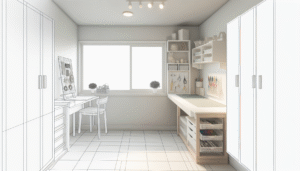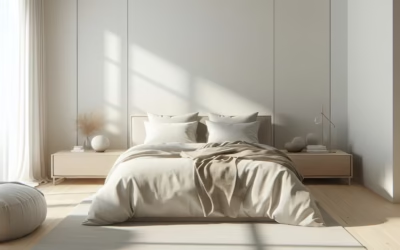
Effortless Elegance: Essential Care Tips for Spotless White Furniture
Opening Section
Maintaining white furniture can feel like a daunting task, especially if you’re someone who cherishes effortless elegance in their home decor. The allure of pristine white furniture is undeniable; it’s light, airy, and adds a touch of sophistication to any setting. Yet, it often comes with the burden of stains, smudges, and dirt that seem to appear out of nowhere. How do you keep that beautiful aesthetic without feeling like you’re constantly cleaning?
In this comprehensive guide, we’ll cover essential tips and tricks for maintaining spotless white furniture, ensuring it remains a stunning centerpiece in your home. From cleaning methods to preventative care strategies, we’ll arm you with the knowledge you need to preserve your elegant decor.
Whether you’re dealing with fabric, leather, or wood finishes, our easy-to-follow advice will help you achieve long-lasting beauty and functionality. By the end of this article, you’ll not only know how to care for white furniture but also how to elevate the overall ambiance of your living space.
Let’s dive in!
Roadmap of Contents:
- Understanding Furniture Materials
- Effective Cleaning Tips
- Preventative Care Strategies
- Dealing with Common Stains
- Maintenance Checklist
- Conclusion & Next Steps
Understanding Furniture Materials
Types of White Furniture Materials
When it comes to white furniture, understanding the material it’s made from is crucial for effective care. The most common types include:
- Wood: Offers a classic look but can be sensitive to moisture and scratches.
- Fabric: Sofas and chairs made from upholstery are comfortable but can trap stains and odors.
- Leather: Durable and stylish, yet can show wear if not taken care of properly.
- Plastic or Acrylic: Easy to clean but may scratch more readily.
Unique Care Needs by Material
Different materials have unique cleaning requirements. For instance:
- Wood: Requires polish and a gentle cleaner.
- Fabric: Needs vacuuming and spot cleaning with specialized upholstery cleaners.
- Leather: Will benefit from leather conditioner to keep it supple and prevent cracking.
- Plastic: Can usually be wiped clean with a damp cloth.
Understanding the nuances of material is fundamental in avoiding damage and ensuring longevity.
Effective Cleaning Tips
General Care Tips
- Dust Regularly: Use a microfiber cloth to dust surfaces weekly. This prevents dirt from building up.
- Use the Right Cleaner: Select cleaners that are suitable for your furniture type. Avoid harsh chemicals that could cause discoloration.
- Spot Test First: Always perform a spot test in an inconspicuous area when trying a new cleaning solution.
Tailored Cleaning Techniques
For Wooden Furniture
- Dust: Regularly dust with a soft cloth.
- Polish: Use a wood polish every few months to maintain shine.
For Upholstered Fabrics
- Vacuum: Vacuum with an upholstery attachment to remove debris.
- Remove Stains: Blot with a damp cloth and a bit of mild detergent to lift stains without damaging fabric.
For Leather
- Clean Weekly: Wipe with a damp cloth and dry immediately.
- Condition: Use a leather conditioner every 6-12 months to maintain softness.
For Plastic or Acrylic
- Simple Wipe Down: Use a cloth damp with warm soapy water and dry thoroughly with a different cloth to prevent water spots.
Preventative Care Strategies
Protecting Your White Furniture
- Use Coasters: Always place drinks on coasters to avoid water rings or discoloration.
- Cover Up: Use throws or decorative covers when not in use, especially on sofas and chairs.
- Avoid Direct Sunlight: Position furniture away from direct sunlight to prevent fading.
Seasonal Considerations
- Humidity Control: Maintain indoor humidity levels; high humidity can warp wood, while low humidity can dry out upholstery.
- Cleaning Routine: Establish a seasonal cleaning routine to prepare your furniture for changing weather conditions.
Dealing with Common Stains
Types of Stains and Solutions
- Food and Drink Stains: Act quickly! Blot gently with cold water and a bit of mild detergent for fabric. For wood, a mixture of vinegar and olive oil can work wonders.
- Ink Stains: For fabric, dab with rubbing alcohol. For leather, a professional cleaner may be necessary.
- Grease and Oily Marks: Use cornstarch on fabric to absorb the oil before vacuuming. Wood surfaces can be treated with a specific wood stain remover.
Quick Repair Techniques
- Fabric: Utilize a fabric patch kit for small tears.
- Wood: Use a furniture marker to cover scratches temporarily.
Maintenance Checklist
Regular Maintenance Tasks
| Task | Frequency |
|---|---|
| Dust Removal | Weekly |
| Vacuum Fabric | Bi-weekly |
| Clean Leather | Monthly |
| Polish Wood | Every 3 months |
| Spot Clean Stains | As needed |
| Seasonal Deep Clean | Twice a year |
Additional Tips
- Store cleaning supplies in an organized way to make cleaning easier.
- Keep an eye out for signs of wear, such as fading or fraying, and take immediate action.
Conclusion & Next Steps
Taking care of your white furniture doesn’t need to be overwhelming. With the right strategies and routine, you can maintain the effortless elegance that white furniture brings to your home. Regular cleaning, preventative care, and quick stain management are essential to ensuring that your pieces remain as beautiful as the day you bought them.
By following the tips outlined in this guide, you’ll keep your furniture spotless and extend its life, allowing you to enjoy a style that never goes out of fashion.
For more insights on home decor and maintenance, check out our other articles on related topics!
FAQ Section
How can I clean white fabric furniture?
To clean white fabric furniture, vacuum regularly to remove dirt, then use a mild detergent mixed with water to spot clean stains. Always spot test new cleaning methods.
What is the best way to remove stains from white leather?
Blot stains quickly with a damp cloth and apply a leather-specific cleaner. For tough stains, consider seeking professional cleaning services.
How often should I polish white wooden furniture?
You should polish white wooden furniture every three months to maintain its shine and protect the finish.
Can I use bleach to clean white furniture?
Avoid using bleach as it can discolor and damage the material. Opt for gentler cleaning solutions that are appropriate for the specific furniture type.
How do I prevent my white furniture from yellowing?
To prevent yellowing, place furniture out of direct sunlight, maintain controlled humidity, and clean regularly with appropriate products.
Content Disclaimer
The information provided in this article is for educational purposes only. For specific cleaning materials or practices, consult with professionals. Results may vary based on individual circumstances and the condition of the furniture.
Categories
- Accent Walls & Ceilings (61)
- Art Curation & Gallery (62)
- Bedding Style Trends (68)
- Bedroom Makeover (81)
- Bohemian & Eclectic Styles (58)
- DIY & Budget-Friendly Decor (64)
- Eco-Friendly Design (62)
- Furniture Care (71)
- Home Decor & Design Ideas (162)
- Home Wellness Spaces (59)
- Integrated Outdoor Living (67)
- Japandi Style (61)
- Kids and Nursery Decor (59)
- Living Room Decor (79)
- Mix & Match Techniques (73)
- Modern & Contemporary Design (66)
- Rug Sizing & Placement (73)
- Scandinavian Design Inspiration (22)
- Seasonal Home Decor (79)
- Small Space Solutions (73)
- Wall Art & Painting Tips (77)
Recent Comments
Archives
Product Gallery
-
 Large Area Green Rugs for Bedroom Nordic Living Room Decoration Shaped Carpet Irregular Plush Lounge Rug Home Thick Washable Mat
Rated 5.00 out of 5$55.01 – $346.86Price range: $55.01 through $346.86
Large Area Green Rugs for Bedroom Nordic Living Room Decoration Shaped Carpet Irregular Plush Lounge Rug Home Thick Washable Mat
Rated 5.00 out of 5$55.01 – $346.86Price range: $55.01 through $346.86 -
 Nordic Style Rugs for Bedroom Morandi Living Room Decoration Carpet Large Area Geometry Lounge Rug Home Cloakroom Non-slip Mat
Rated 5.00 out of 5$39.51 – $598.43Price range: $39.51 through $598.43
Nordic Style Rugs for Bedroom Morandi Living Room Decoration Carpet Large Area Geometry Lounge Rug Home Cloakroom Non-slip Mat
Rated 5.00 out of 5$39.51 – $598.43Price range: $39.51 through $598.43 -
 Irregular Shapes Living Room Decoration Carpet Modern Style Rugs for Bedroom Home Thicken Plush Rug Fluffy Soft Lounge Floor Mat
Rated 4.83 out of 5$55.91 – $347.82Price range: $55.91 through $347.82
Irregular Shapes Living Room Decoration Carpet Modern Style Rugs for Bedroom Home Thicken Plush Rug Fluffy Soft Lounge Floor Mat
Rated 4.83 out of 5$55.91 – $347.82Price range: $55.91 through $347.82











